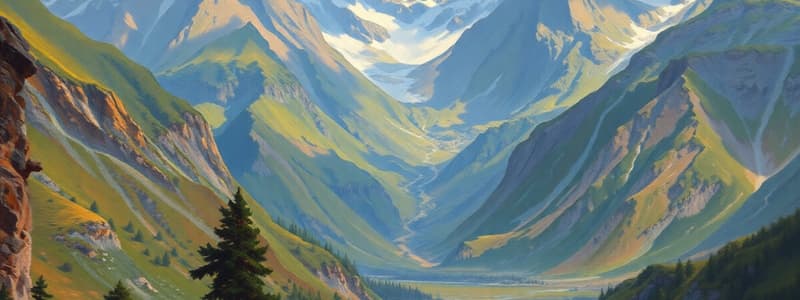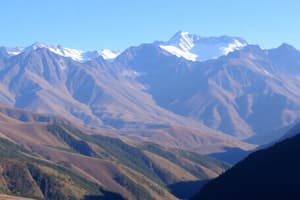Podcast
Questions and Answers
Flashcards
South American Regions
South American Regions
The three major regions of South America are the northern tropics, the Andean countries, and the southern grassland countries.
Guianas' Economy
Guianas' Economy
The Guianas (Suriname, French Guiana, and Guyana) share similar economic activities due to their common natural resources: fishing, mining, and farming.
Farming in the Andes
Farming in the Andes
The Andes, the world's longest mountain range, present challenges for farming. Most of the land is too steep, but some crops are grown on high plateaus and in narrow valleys.
The Pampas and Farming
The Pampas and Farming
Signup and view all the flashcards
Hydroelectric Dams in South America
Hydroelectric Dams in South America
Signup and view all the flashcards
Andean Culture
Andean Culture
Signup and view all the flashcards
The Gaucho
The Gaucho
Signup and view all the flashcards
Spanish Cultural Influence in South America
Spanish Cultural Influence in South America
Signup and view all the flashcards
Study Notes
Geographic Context
- South America is divided into three regions: the northern tropics, the Andean countries, and the southern grasslands.
- The Guianas (Suriname, French Guiana, and Guyana) share similar economies due to shared natural resources like fishing, mining, and farming.
- People of mixed African and other ancestry are called mulattoes.
- The Andes are the world's longest mountain range.
- The Pampas are vast fertile plains used for ranching and commercial farms.
Land Use and Resources
- The Andes have limited farmland, with much of the eastern areas covered by tropical rainforest, unsuitable for large-scale farming.
- Farming in the Andes takes place on high plateaus and narrow mountain valleys.
- A variety of crops, like wheat, coffee, corn, potatoes, and many fruits/vegetables, are grown in vertical climate zones within the Andes.
- Commercial farming in the Andes is mainly in the western foothills and coastal areas of Ecuador and Peru.
- Subsistence farming occurs at higher elevations in the Andes.
- The Pampas are ideal for cattle ranching, attracting early settlers.
- Valuable resources like gold, silver, and copper were mined by the Spanish in the Andes highlands of Peru and Bolivia.
Human Interaction with the Environment
- Humans interact with the environment through commercial farming, subsistence farming, mining, and cattle ranching.
- Hydroelectric dams are built to generate electricity by utilizing the power of falling water.
- Construction of dams can negatively impact delicate ecosystems, like the flooding of river valleys in Chile (as an example).
Rich Culture
- South American culture is rooted in the combined legacies of Europeans and Native Americans, clearly visible across the region.
- The guacho is a symbol of independent life in the Pampas.
- Andean music blends Spanish stringed instruments with ancient Native American music traditions..
- Spanish culture, language, Catholicism, architecture, art, and dance are prevalent in the region.
- Mestizos and indigenous peoples strongly influence Andean culture.
- Native cultures have historically contributed to the region's traditions despite population declines.
- Traditional practices like llama and alpaca raising continue in countries like Peru, Bolivia, Ecuador, and Chile.
Studying That Suits You
Use AI to generate personalized quizzes and flashcards to suit your learning preferences.
Related Documents
Description
This quiz explores the geographical divisions, land use, and resources of South America. It covers regions like the northern tropics, the Andes, and the Pampas, as well as farming practices and economic activities in the Andes. Test your knowledge about the diverse cultures and environments of this continent.




